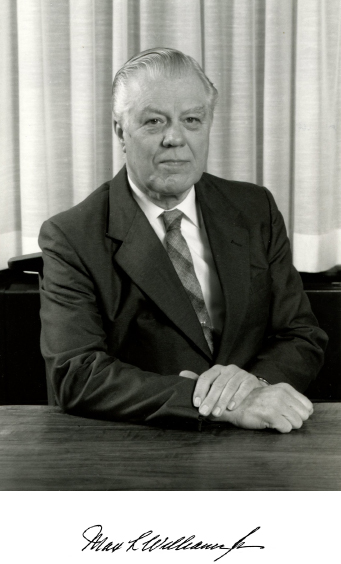1922–2013
Elected in 2003
“For fundamental developments in fracture mechanics and for providing guidance to industry and government that has facilitated technology transfer.”
BY K.L. (LARRY) DEVRIES
SUBMITTED BY THE NAE HOME SECRETARY
MAX L. WILLIAMS JR., a pioneer and leader in fracture mechanics, passed away on September 18, 2013. He was 91.
Williams was born in the Aspinall neighborhood of Pittsburgh on February 22, 1922. Twenty years later, he would obtain his bachelor’s degree at the Carnegie Institute of Technology in Pittsburgh. He entered the US Air Force as a captain and an aircraft maintenance engineer in 1943 before earning his MS (1947), engineer’s degree (AE; 1948), and PhD (1950), all in aeronautics, from the California Institute of Technology. He then went from lecturer to tenure-track professor of aeronautics.
Early in his academic career, Williams was internationally renowned as a pioneer in fracture mechanics. His identification of the universal nature of the stress field at the tip of a crack became the cornerstone for the field of fracture mechanics through the development of the single most important parameter controlling fracture. He was a prime contributor to introducing the solid rocket motor industry—then dominated by chemical engineers—to viscoelastic, structural failure analysis. Even today you can open any number of fracture mechanics books to find M.L. Williams referenced. In addition, he was the founding and long-time editor in chief of the premiere journal on fracture mechanics, the International Journal of Fracture.
Fracture mechanics is in part a mature field thanks to his pioneering work. No structural fracture/failure analysis could be conceived without his contribution; he even pioneered the extension of these concepts to the mechanics of earthquake generation in the 1950s and to adhesive joints in the 1960s. During the height of the Cold War, Williams was instrumental in developing the tools for the failsafe operation of solid propellant rocket motors (e.g., Polaris, SRAM, and Minuteman), which made the national defense and space efforts viable.
For example, the influence of those developments concerning the mechanical behavior of polymeric materials was felt through the Richard Feynman analysis of the O-ring seals in the Challenger disaster. Williams’ influence is also felt throughout the engineering field where mechanical applications of polymers in today’s engineering environments are involved.
Williams left the research culture of Caltech to become dean at the University of Utah College of Engineering in 1965. He was an effective but demanding dean, making a number of improvements and important faculty hires as well as focusing on research and graduate studies. Under his administration, the Departments of Computer Science, Bioengineering, and Materials Science and Engineering were added to the college. He also created a need-based scholarship program for underrepresented students.
In 1973 Williams resigned from the University of Utah as well as from much of his personal research to accept the position of dean of the School of Engineering at the University of Pittsburgh, where he was also a professor until 1985. Later, he became more involved as an advisor for government agencies.
Throughout his career, he demonstrated a firm belief in practical, hands-on engineering. He was a registered engineer and had a major influence in guiding national programs of defense research, saving millions of dollars by judiciously supporting, criticizing, or phasing studies and programs. His practical insights transitioned into engineering management through guidance of over 20 engineering startups, which depended critically on mature engineering judgment.
Elected to the NAE in 2003, Williams was a consummate lecturer and held many appointments nationally and internationally. His national impact is memorialized through his involvement in numerous government committees ranging from the US Department of State to NASA and the Office of Science and Technology Policy.
Dr. Williams is survived by his loving wife of 46 years, Mel; children Gregory and Richard Williams and Christine Mann; and stepchildren Pamela Allande, Marilyn Shupe, and Walter McKinney.





